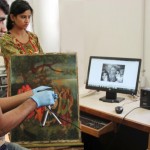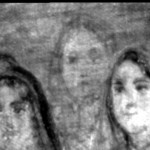Examination
Conservators employ a number of examination and imaging techniques to explore the multiple layers of a painting, layers that are both visible and invisible to the naked eye. Some of these approaches require the simple use of unusual lighting angles, while others involve very specialized equipment capable of producing or capturing electromagnetic wavelengths above or below the narrow band of the visible spectrum namely ultraviolet and infra-red light rays.
Examination under UV light
Examination under ultraviolet light is applied to assess the nature and condition of the varnish and restoration layers lying on the surface of the painting. Under this short wavelength light materials fluoresce and phosphoresce depending on their properties. The differences in the age and chemical composition of painting media and surface coatings (varnish layer) can be detected by the difference in fluorescence



Painting (left) under UV right (right) showing different fluorescence. The aged layers are greenish yellow in colour while later additions appear purplish in colour.
Infrared Reflectography
Infrared reflectography involves examination using the longer wavelength infrared radiations where a special infrared camera captures the light reflected off the surface of the painting. As these rays penetrate through the layers of painting, layers of painting otherwise not visible to naked eye such as underdrawings and changes in painting are revealed.



Infrared reflectogram or digitized black-and-white image (left) of a part of painting (right) showing an under drawing of a female face no longer visible in the painting.









